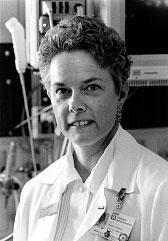Vascular surgeon McDaniel is to be chair of anatomy
"I'm standing on the shoulders of giants," says Martha McDaniel, M.D., of those who have, over the years, built up the DMS Department of Anatomy, one of the School's oldest departments. She will succeed that pantheon as chair of the department in July of 2001. The first woman named permanent chair of a DMS department, she will be replacing Stanley Carpenter, Ph.D., who retired recently after 34 years on the Dartmouth faculty.
Fundamentals: "Dartmouth has made a wise choice," says Donald Cahill, Ph.D., a nationally recognized anatomist who is a visiting professor and the acting chair of the department during the transition. "She is an outstanding surgeon who has chosen to devote herself to the important fundamentals of medical education." Cahill, who cited Mc- Daniel's "personal warmth, generosity, experience, and keen interest in anatomy," is editor-inchief of Clinical Anatomy and has been a faculty member at Northwestern, the University of Miami, and Mayo.
McDaniel, a vascular surgeon, says, "There is a now-growing tradition of having surgeons who are finished with their active clinical practice continue to contribute their expertise to the community by teaching medical students about anatomy. Surgeons . . . work with anatomical features all the time . . . and they understand the medical problems that can be associated with malfunction of one anatomic feature or another."

|
|
Martha McDaniel was a vascular
surgeon for nearly 20 years at the
DMS-affiliated VA Medical Center
in White River Junction before
being named chair of anatomy. |
A 1977 graduate of DMS, McDaniel has been a member of the Dartmouth faculty since 1983. She served for eight years as chief of the vascular surgery section at the White River Junction, Vt., VA Medical Center. From 1993 to 1997, she was associate chief of staff of education at the VA and from 1996 to 1999, acting chief of the surgical service. In addition to her clinical responsibilities, McDaniel has worked for more than 10 years teaching an anatomy refresher for fourth-year students who plan to enter surgery. Last year she received the Department of Surgery's Arthur Naitove Distinguished Teaching Award.
Relevant: In her new role, she will be considering questions like "how to help students retain the tremendous volume of information that's coming to them, usually for the first time, and how to make it clinically relevant," she says. "Dartmouth has a long history of focusing on the clinical relevance of anatomy . . . but it's an issue for medical schools all over the globe—how much to teach structure and its variations and how much to ignore the details and focus on larger public health problems."
Although DMS students take the anatomy course in their first year, McDaniel wonders whether it should be part of "the second or third year [so] students have enough familiarity with patients and their common problems in order to help them focus and organize the vast amount of anatomical information that needs to come their way."
Recalling her own experience at DMS, she says she felt "probably like any other first-year medical student—scared, uncertain of whether the cadaver really was dead. I don't recall having a good understanding of the body donation process and the commitment that donors and their families make to future students by donating their bodies to research and education. An important part of the acclimatization process is helping students understand how their particular cadaver came to be present in the dissecting laboratory."
McDaniel believes that Webbased resources can be useful in learning anatomy but will never be a substitute for dissection of a human cadaver. "The more ways we can offer the students to visualize this very complicated machine, the better they're going to be able to assimilate the information," she says.
The anatomy department —which is responsible for teaching human anatomy, embryology, and normal histology—has been considering a number of other ideas. One, McDaniel says, is whether anatomy teachers should be available to students in later years—"like during the time they're learning physical diagnosis, or when they encounter an orthopedic joint problem—to review the anatomy and understand exactly what it is that they're feeling."
Anatomy would then not be "isolated to the first year," Mc- Daniel explains, "but [would] pop up again in time to help people understand situations they haven't seen before."
Innovation: She and a team of faculty and students will be examining other innovative programs in the U.S. and Europe "to learn whether there are features of their teaching programs that we should be incorporating here at Dartmouth."
DMS is unusual "in having a number of clinicians teaching anatomy," McDaniel says proudly. "It's a good mix of classically trained anatomists and people who have had significant clinical experience."
Laura Stephenson Carter
If you would like to offer any feedback about this article, we would welcome getting your comments at DartMed@Dartmouth.edu.
